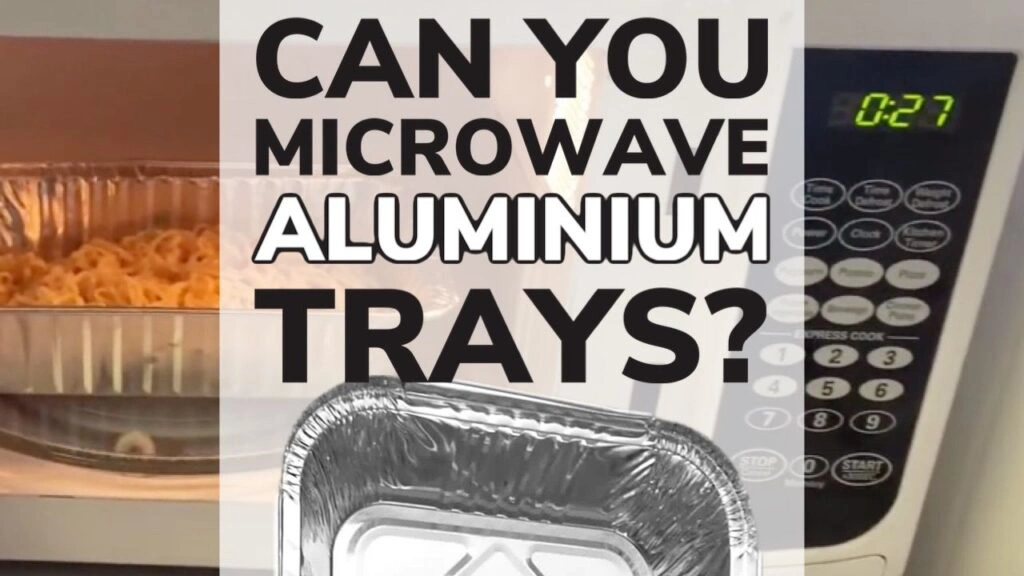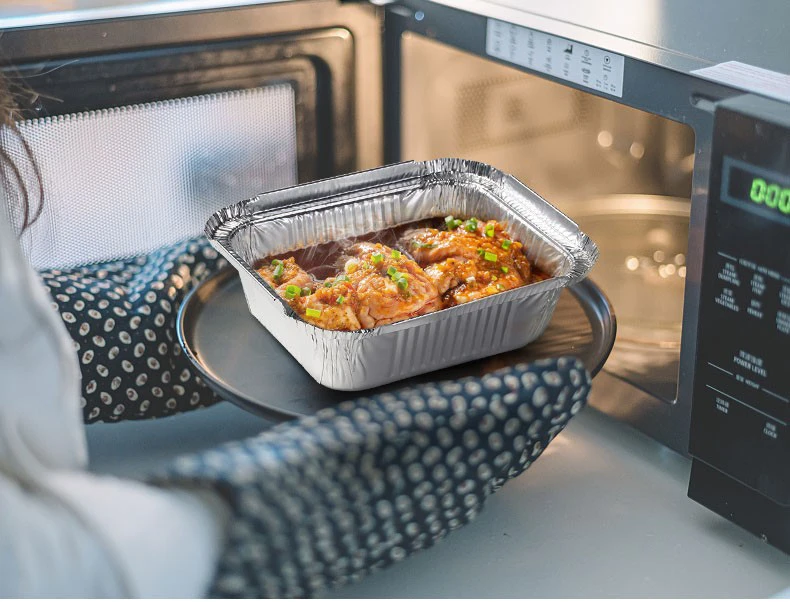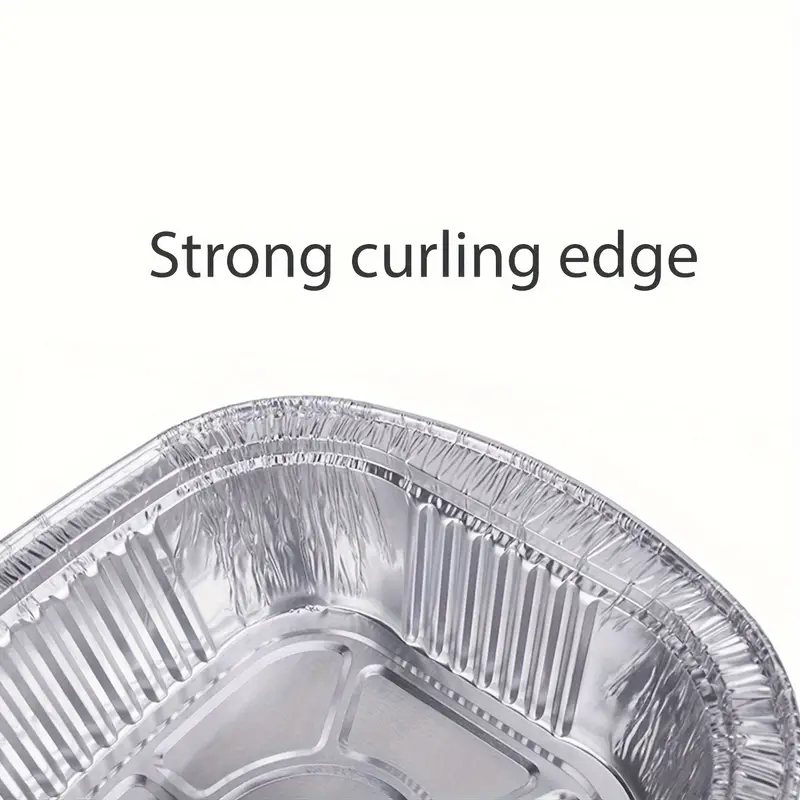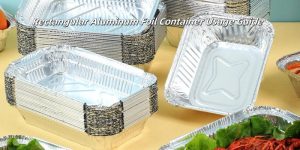
Microwave and oven-safe aluminum foil trays heat evenly for reliable cooking. Ideal for grilling to prevent burning and packaging refrigerated, frozen, and fresh foods. Aluminum trays are safe to heat directly in their packaging with no harmful chemical release, ensuring food safety. They are safer, more hygienic, and more reliable than other disposable containers.
Use Microwave or Oven to Heat Foil Trays

- Aluminum food tray must be filled with food. Risk of burning if not filled.
- Remove the aluminum lid before heating for safety. Cover with a microwave-safe plate or wrap if needed.
- Metal and metal cannot touch each other. The aluminum tray cannot come into contact with the furnace wall, furnace door, furnace bottom, and other metal parts. Otherwise, the resulting arc may damage the microwave. Also, avoid plates with gold or silver decorations.
- The foil pan should always be kept 2 cm away from the oven wall or 2 cm away from other foil pans. For example, an aluminum tray can be placed on a porcelain plate.
- Since food absorbs microwaves from above, cooking and heating times increase by approximately 10%.
- Do not use bent or damaged aluminum trays, and do not reuse aluminum foil sheets. Please wash and recycle.
In freezers, wrap trays tightly in plastic wrap or foil to prevent freezer burn. Thaw frozen foods in the refrigerator—never microwave foil trays, as sparks can occur. For acidic foods (e.g., tomato sauce), opt for coated aluminum trays to prevent metallic leaching.
Warning: Sudden temperature changes (e.g., moving trays from freezer to oven) can cause cracking. Gradually adjust temperatures for safe use.
Aluminum Foil Tray Sizes
| Aluminum Trays Model | Size | Depth | Capacity | Thickness | Weight | Packing |
| YSA-B525A | Top out: 525x328mm Top in: 495x300mm Bottom: 440x245mm | 76mm | 9700ml | 0.147mm | 100g | 50pcs |
| YSA-B525B | Top out: 525x326mm Top in: 508x308mm Bottom: 473x277mm | 42mm | 5360ml | 0.135mm | 87g | 50pcs |
| YSA-B466 | Top out: 466x268mm Bottom: 354x352mm | 80mm | 6885ml | 0.12mm | 66g | 50pcs |
| YSA-T455 | Top out: 455x360mm Top in: 410x330mm Bottom: 354x280mm | 85mm | 7585ml | 0.116mm | 75g | 50pcs |
| YSA-T470 | Top out: 470x345mm Top in: 436x326mm Bottom: 380x268mm | 84mm | 6800ml | 0.127mm | 76g | 50pcs |
| YSA-B430 | Top out: 430x310mm Top in: 395x275mm Bottom: 355x240mm | 65mm | 5830ml | 0.11mm | 70g | 50pcs |
| YSA-P345 | Top out: 345x246mm Top in: 320x234mm Bottom: 250x137mm | 21mm | 990ml | 0.115mm | 22g | 200pcs |
| YSA-P545 | Top out: 545x362mm Top in: 513x333mm Bottom: 400x218mm | 21mm | 2270ml | 0.15mm | 65g | 50pcs |
Safety Precautions
Correct Operation
Please wear heat-resistant and cut-resistant gloves when handling hot or sharp-edged aluminum foil trays to avoid cuts or burns. Clean aluminum trays before/after use. Store in cool, dry, shaded areas. Keep dry to avoid oxidation and mold.
Avoid Pollution
Before using your aluminum foil tray, make sure it is clean and free of any residue or particles. Clean aluminum foil trays with warm soapy water and rinse fully. Always select food-grade labeled trays for safety. Use separate trays when handling raw meats/seafood to avoid cross-contact.
Food Cooking Precautions
Cooking and Baking
Due to the reflective properties of aluminum foil trays, it may cause excessive browning or burning of food. To prevent this, cover the top of the tray with foil to prevent food from burning, or adjust cooking time and temperature accordingly. Keep food safe in your fridge or freezer by always sealing foil trays with tight-fitting lids to block odors and avoid cross-contamination.

Food Storing
When storing leftovers in foil trays, seal with foil or transfer to an airtight container. Protect foil trays from corrosion by avoiding long-term storage of acidic or salty foods like tomato sauce and citrus fruits. Because acidic and salty foods react with aluminum and may affect the taste of the food.
If you store food in foil trays in the refrigerator, be careful not to stack them and place them directly on the refrigerator shelves.
Reheating and Microwaving
Before reheating food in tin foil serving trays, be sure to remove any foil lids or coverings. Never place foil trays with metal parts, such as foil lids or handles, directly into the microwave. Metal can cause arcing and damage equipment.
If you want to reheat food in a catering aluminum tray, make sure the tray is microwave-safe. Follow the manufacturer’s instructions for recommended heating times and power levels to prevent overheating or uneven cooking.
Choose a Reliable Manufacturer
Source aluminum tray suppliers with ISO 9001, FDA, BRC, or CE certifications to ensure food-safe production standards and reliable quality control. Read customer reviews and ratings; these opinions will surely help you.
If you want to buy aluminum trays in bulk, you also need to confirm whether the manufacturer is authentic. You can ask the manufacturer for samples. As long as you are satisfied with the sample and the manufacturer, you can purchase with confidence.
Check Aluminum Tray
Inspect the foil plate for dents, holes, or other visible damage. Verify that the foil tray size and capacity meet your needs. Pay attention to the thickness and strength of the foil used in the tray. Thicker foils tend to be more durable and less likely to tear or puncture.

Disposal and Recycling
Clean food residue after use, separate aluminum trays for recycling, and check local guidelines. Flatten trays if recyclable in your area.
How to Clean Aluminum Foil Trays Without Damaging
Cleaning aluminum foil trays properly ensures longevity and prevents contamination.
Start by rinsing trays immediately after use with warm water to remove food residues. Avoid abrasive scrubbers or steel wool, as these can scratch the surface and compromise the tray’s structural integrity. For stubborn grease, soak trays in a mixture of baking soda and warm water for 15–20 minutes before gently wiping with a soft sponge.
Never use harsh chemicals like bleach or oven cleaners, as they can react with aluminum and leave toxic residues. For sanitization, boil trays in water for 5–7 minutes or use a vinegar solution (1:3 ratio with water). Always dry trays thoroughly with a microfiber cloth to prevent water spots and oxidation.
Pro Tip: Store cleaned trays in a dry, cool place to avoid moisture buildup, which can cause corrosion. If discoloration occurs, soak trays in lemon juice or citric acid for 10 minutes to restore shine.
How to Prevent Food Contamination in Foil Trays
Use high-quality, food-grade aluminum trays with certifications like FDA or LFGB. Avoid storing highly acidic or salty foods for extended periods, as these can corrode aluminum. Line trays with parchment paper for added protection when storing raw meats or fish.
For marinating, limit contact time to 2–4 hours and refrigerate trays immediately. Never reuse trays that held raw proteins without thorough sterilization (e.g., boiling for 10+ minutes). Opt for anodized or non-stick coated trays for sensitive foods like dairy or desserts.
Are All Foil Trays The Same
No—foil tray thickness (measured in microns) determines durability. For household use, 40–60 micron trays work for baking and short-term storage. Commercial kitchens require 80–120 micron trays to withstand heavy sauces and frequent reheating.
Check thickness by pressing the tray—thin trays dent easily. For grill use, choose trays with ribbed bottoms (prevents warping). Always match tray size to dish volume: overfilling causes spills, while underfilling leads to uneven heating.
You need to konw: Heavy-duty trays (100+ microns) cost 20% more but last 3x longer than standard options.



